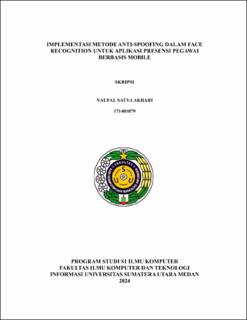| dc.description.abstract | In the digital era, facial recognition technology is becoming increasingly
widespread, particularly in mobile-based employee attendance applications.
However, the main challenge faced is security, specifically spoofing attacks that
can deceive the system with fake data. This research examines the application of
anti-spoofing methods such as liveness detection, texture analysis, and motion
analysis to address this issue. Liveness detection checks for signs of life, such as
eye and lip movements, to ensure the authenticity of the face captured by the
camera. The methodology involves developing a facial recognition system with
anti-spoofing features and testing it against various types of spoofing attacks.
The system implementation includes an optimized IFaceNet model and an
ONNX model for detecting liveness. The dataset is divided into training,
verification, and test sets in a ratio of 8:1:1. The research results show that the
applied anti-spoofing methods significantly enhance the security and reliability
of the mobile-based employee attendance system. The direct detection accuracy
reached 94.72%, with a precision of 93.43% and recall of 95.08% on the test
data. On the validation data, the model achieved an accuracy of 89.77%,
precision of 88.96%, and recall of 89.23%. This performance indicates that the
model is quite fit but there is still room for improvement, especially in reducing
the performance gap between training and validation data. Thus, this system is
effective in detecting and countering spoofing attacks and can be applied in
various usage contexts. | en_US |


